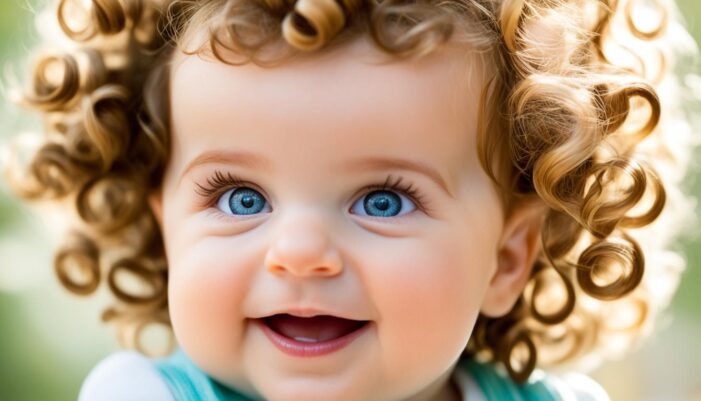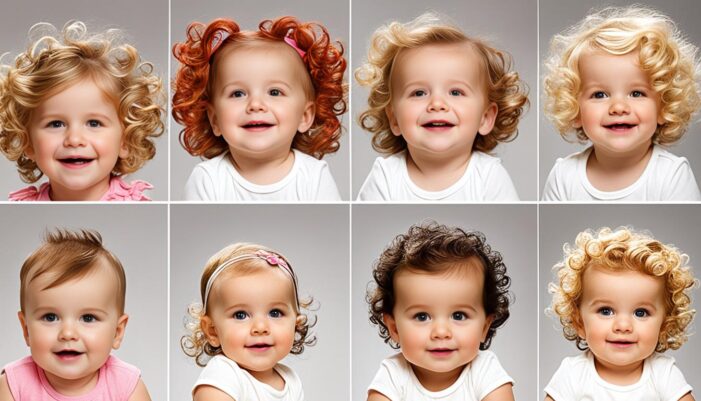As a new parent, navigating the diverse world of baby hair types can be both exciting and overwhelming. From silky straight locks to bouncy curls, each little head of hair is as unique as the child it adorns. In this comprehensive guide, we’ll explore the different baby hair types and provide expert tips to help you care for your little one’s tresses with confidence and love.
Whether your baby has fine, wavy strands or thick, coily curls, understanding the unique needs of their hair is essential for promoting healthy growth and maintaining a beautiful, manageable style. From establishing a gentle hair care routine to discovering styling techniques that celebrate natural texture, this article will empower you to embrace your child’s hair type with joy and enthusiasm.
Key Takeaways
- Discover the diverse range of baby hair types, from straight to curly
- Learn expert tips for caring for each unique hair texture
- Establish a gentle, nurturing hair care routine for your little one
- Explore styling techniques that celebrate your baby’s natural hair
- Gain confidence in managing and loving your child’s beautiful locks
Understanding Different Baby Hair Types
Caring for your baby’s hair starts with understanding the diverse range of hair types they may have. The curliness of hair is determined by the shape of the hair follicle, with straight hair being the easiest to identify. However, curly hair encompasses a wide spectrum, from loose waves to tight coils.
Types of Curly Hair
The hair type classification system, known as the curl pattern scale, ranges from 2A (loose waves) to 4C (tight, kinky coils). As the hair types progress from 2 to 4 and from A to C, the hair generally becomes more prone to dryness but also more versatile in styling.
- 2A-2C: Loose, S-shaped waves
- 3A-3C: Defined, springy curls
- 4A-4C: Tight, Z-shaped coils
Knowing your child’s specific curl type will help you choose the right products, tools, and techniques to nourish and define their natural texture. This understanding is key to managing different curl patterns and ensuring your baby’s hair remains healthy and vibrant.
“Embracing your baby’s natural hair texture is the first step towards building confidence in their unique beauty.”
Building Confidence in Curly Hair Babies
Embracing your baby’s curly hair is not just about proper care – it’s also about nurturing their self-esteem and celebrating their natural beauty. As a parent, it’s crucial to avoid any negative talk about curly hair and instead, focus on promoting a positive outlook.
Curly-haired babies have a unique and captivating texture that deserves to be celebrated. By highlighting the qualities that make their hair special, you can help build confidence and foster a lifelong appreciation for their natural assets. Curly hair positive affirmations, such as “Your hair is beautiful and full of life,” can go a long way in reframing any challenges as opportunities for growth and self-discovery.
When caring for your baby’s curly locks, resist the urge to complain about tangles or frizz. Instead, make a conscious effort to praise their voluminous, eye-catching mane and share your excitement about learning the best ways to nurture their natural texture together. By embracing the beauty of curly hair, you’ll set your child up for a lifetime of self-love and acceptance.
“The most beautiful thing you can wear is confidence.” – Jes Baker
Remember, building confidence in curly-haired children is not just about their appearance – it’s about empowering them to embrace their unique qualities and see the world through a lens of self-acceptance. So, let’s celebrate the natural beauty of curly hair and help our little ones feel proud of who they are, inside and out.

As you navigate the joys and challenges of caring for your baby’s curly hair, keep in mind that every texture is a cause for celebration. By reframing any difficulties as opportunities for growth and bonding, you’ll not only help your child develop healthy self-esteem, but you’ll also deepen your connection and create lasting memories filled with love and acceptance.
baby hair types: Daily Care and Styling Tips
Caring for your baby’s hair, regardless of type, requires a gentle and intentional approach. From daily maintenance to bath time routines, the right techniques can make all the difference in keeping your little one’s locks healthy and vibrant.
Daily Curly Hair Care for Babies
For curly-haired babies, start the day with a light misting of water and a gentle detangling session using a wide-tooth comb. This helps to maintain the natural curl pattern without causing unnecessary frizz or breakage.
Bathing and Drying Curly Baby Hair
When it’s time for bath time, limit shampooing to every few days to avoid stripping the hair of its natural oils. Always follow up with a nourishing conditioner to keep curls soft and manageable. After rinsing, gently squeeze excess water from the hair using your hands or a soft cotton t-shirt, rather than roughly toweling dry.
Using the Right Products for Baby Hair
Choosing the right products is essential for maintaining healthy baby hair. Seek out gentle, sulfate-free formulas that are specifically designed for delicate, developing strands. Avoid products with harsh chemicals that can cause dryness or irritation.
Managing Tangles and Frizz
To tame tangles and keep frizz at bay, use a leave-in conditioner or a nourishing hair oil after bathing. Apply these products from mid-length to the ends, gently combing through with your fingers or a wide-tooth comb.
Protecting Hair at Night
Nighttime can be tough on baby hair, with friction from tossing and turning causing tangles and breakage. Protect your little one’s locks by using a silk pillowcase or a soft, satin turban to minimize friction and preserve the style.
Finding the Right Hairstylist for Curly Cuts
When it’s time for a haircut, seek out a stylist who specializes in cutting curly or textured hair. They’ll be able to shape and style your baby’s locks in a way that enhances their natural curl pattern and showcases their unique beauty.
By incorporating these daily care and styling tips, you can ensure your baby’s hair stays healthy, manageable, and true to its natural texture.
Conclusion
Embracing and caring for your baby’s unique hair type is a journey of love and discovery. By understanding the different hair classifications, building confidence in their natural texture, and implementing gentle, nourishing care routines, you’ll set your little one up for a lifetime of healthy, beautiful hair. Remember, every baby’s locks are a true gift, and with the right approach, you can help your child cherish their special strands from the very beginning.
Whether your little one has straight, wavy, curly, or coily hair, the key is to approach their tresses with patience, care, and a deep appreciation for their natural beauty. By celebrating the diversity of baby hair types and providing the right products and techniques, you can unlock the full potential of your child’s locks and empower them to embrace their unique identity from an early age.
As you continue on this hair journey with your baby, remember to stay flexible, experiment with different styles and techniques, and most importantly, have fun! Every child’s hair is a masterpiece waiting to be unveiled, and by nurturing their locks with love and attention, you’ll witness the incredible transformation that takes place as they grow and develop. Embrace the beauty of your baby’s hair, and embark on a fulfilling adventure that will last a lifetime.
FAQ
What are the different types of baby hair?
Baby hair can range from silky straight to bouncy curls. The curliness of hair is determined by the shape of the hair follicle, with straight hair being the easiest to identify. Curly hair, however, spans a wide range, from loose waves (2A-2C) to tight coils (4A-4C). Knowing your child’s specific curl type will help you choose the right products, tools, and techniques to nourish and define their natural texture.
How can I build confidence in my baby’s curly hair?
It’s essential to approach caring for your baby’s curly hair with a positive mindset. Resist the urge to complain about tangles or frizz, as this can inadvertently damage your child’s self-esteem. Instead, make a conscious effort to praise their beautiful, voluminous locks and share your excitement about learning something new together. Reframe any challenges as opportunities to bond and discover the best ways to nurture your child’s natural texture. By building confidence in their curly hair from an early age, you’ll set them up for a lifetime of self-love and acceptance.
What are some daily care and styling tips for different baby hair types?
Caring for your baby’s hair, regardless of type, requires a gentle, intentional approach. For daily maintenance, lightly mist the hair with water and use a wide-tooth comb to gently detangle without disrupting the natural curl pattern. For bath time, limit shampooing to every few days to avoid excessive dryness, and always follow with a hydrating conditioner. When drying, avoid rough towels or heat from blow dryers, which can cause frizz. Instead, gently squeeze excess water with your hands or a cotton t-shirt. At night, use a silk pillowcase or turban to minimize friction and breakage. And when it’s time for a haircut, seek out stylists experienced in cutting curly or textured hair to ensure the perfect shape for your little one’s locks.

